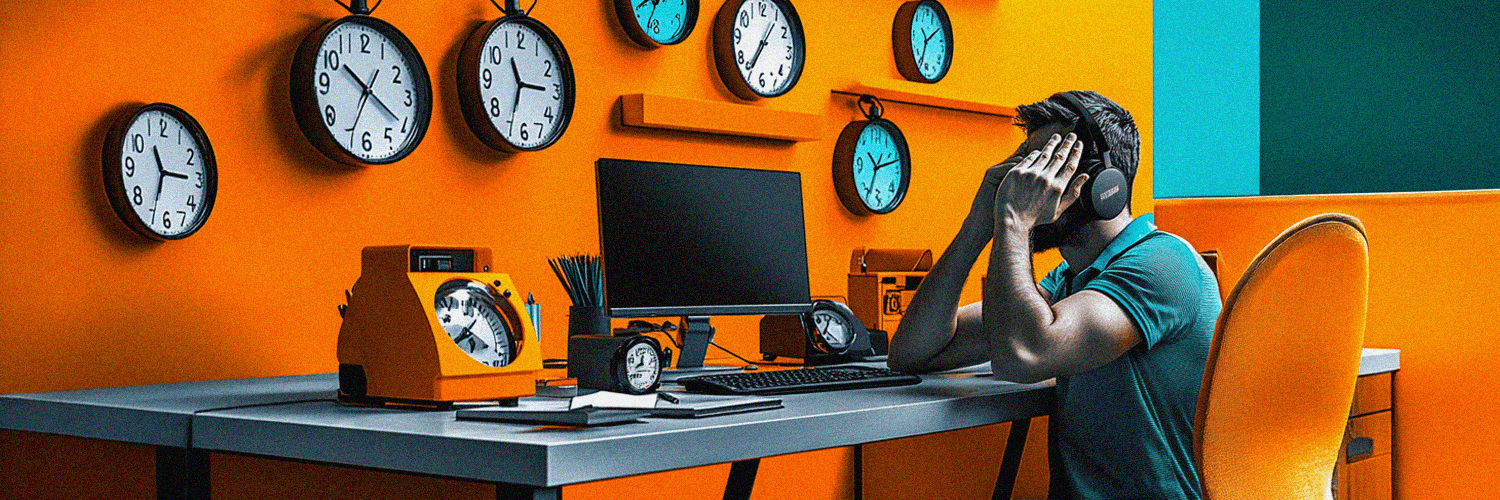The hybrid work model blends traditional office settings with remote work flexibility, fundamentally reshaping how organizations approach workplace management. As this model becomes increasingly established across industries, understanding its comprehensive benefits backed by recent research becomes essential for forward-thinking organizations.
In this article, we'll explore ten evidence-based advantages of hybrid work, supported by the latest statistics highlighting its positive impact on productivity, employee satisfaction, and organizational growth. We'll also examine the four main hybrid work models being implemented today, address common implementation challenges, and provide practical guidance for successful adoption.
As hybrid work transitions from a pandemic response to a permanent workplace strategy, organizations that master this approach gain significant competitive advantages in talent acquisition, employee retention, and operational efficiency.
TL;DR:
- Hybrid work models blend in-office and remote work, optimizing both productivity and employee satisfaction through increased flexibility and autonomy.
- Recent Stanford research from June 2024 shows hybrid work has "zero effect on productivity or career advancement" while dramatically boosting retention rates by 33%.
- The four main hybrid work models are: Fixed/Specific Onsite Days, Flexible/Employee-Led, Office-First, and Remote-First, each with distinct advantages for different organizational needs.
- Hybrid work increases employee engagement, with professionals working in hybrid models showing the highest engagement rates at 35%, compared to fully remote (33%) and in-office employees (27%).
- Companies adopting hybrid models can save approximately 50% on office space and real estate costs while employees save up to $12,000 annually on commuting and work-related expenses.
- 90% of CEOs report that hybrid work adoption contributes directly to reduced costs, while 95% of business leaders say their organizations have become more flexible in the past two years.
- Successfully implementing hybrid work requires addressing key challenges including technology integration, leadership skills, and ensuring equitable treatment between remote and in-office employees.
Understanding the Hybrid Work Model and its Benefits
The hybrid work model is a flexible employment framework that allows employees to blend working on-site and remotely according to predefined arrangements or their personal preferences. Rather than being a single uniform approach, hybrid work encompasses various structured models tailored to optimize productivity, improve employee well-being, and accommodate diverse working styles and life commitments.
At its core, hybrid work empowers employees with greater autonomy to choose where they work best—whether that's the collaborative energy of an office environment or the focused quiet of a home workspace. According to research from Gallup in 2023, approximately 53% of employees with remote-capable jobs now expect a hybrid arrangement, and about 60% prefer this model over fully remote or fully in-office options.
The benefits of hybrid work extend far beyond simple flexibility. Nicholas Bloom's landmark Stanford study published in June 2024 found that hybrid workers are just as productive and as likely to be promoted as their fully office-based counterparts, while resignations fell by an impressive 33% when companies implemented hybrid arrangements. This research conclusively establishes that hybrid work is a win-win-win for employee productivity, performance, and retention.

Evolution of Hybrid Work: From Exception to Standard Practice
Hybrid work wasn't born overnight; it evolved gradually from early flexible work experiments before accelerating dramatically during recent global disruptions. Initially, forward-thinking companies offered flexible or remote options as early as the 2000s, primarily as accommodations for specific circumstances rather than standard practice.
Technological advances in cloud computing, video conferencing, and collaborative tools throughout the 2010s made remote work increasingly viable, laying essential foundations for broader hybrid adoption. However, as recently as 2019, only about 5,7% of work time in the United States was spent working from home.
The COVID-19 pandemic in 2020 catalyzed an unprecedented shift, forcing organizations to rapidly implement remote work at scale. This mass experiment revealed both the potential and limitations of fully remote arrangements. While many employees appreciated newfound flexibility, challenges including collaboration difficulties, digital fatigue, and social isolation demonstrated that purely remote work wasn't ideal for everyone.
As pandemic restrictions eased, the hybrid model emerged as a balanced approach combining the best aspects of both worlds. According to CNBC's report from 2023, 39% of new hires now operate under some form of hybrid work arrangement. Throughout 2023, the percentage of paid full days worked from home each month averaged 30% for U.S. workers, with this figure remaining remarkably steady despite declining from pandemic peaks.
As of 2025, approximately 52% of U.S. employees in remote-capable jobs are working in a hybrid model, according to Gallup's latest data.
Four Main Types of Hybrid Work Models
Organizations implementing hybrid work typically adopt one of four primary models, each with distinct structures, advantages, and ideal use cases:
1. Fixed/Specific Onsite Days Model
This structured approach requires employees to work onsite on predetermined days (e.g., Monday-Tuesday in office, Wednesday-Friday remote) with uniform schedules determined by company policy. The fixed model offers predictable scheduling for meetings and collaboration while enabling streamlined office resource management. However, its limited flexibility may not address all employee personal needs.
Real-world implementation: Disney follows a fixed hybrid work model, requiring employees to be onsite from Monday to Thursday. This structure emphasizes the value of in-person collaboration, creativity, and mentorship—key elements in Disney’s culture. CEO Bob Iger has highlighted that face-to-face interactions are essential for building strong teams and fostering innovation. While the model leaves little room for flexibility, it aims to strengthen connection and consistency across teams by bringing people together on the same days each week.
2. Flexible/Employee-Led Model
The employee-led approach allows workers to choose which days to work remotely versus onsite, typically with minimal restrictions. This maximum flexibility supports work-life balance, attracts talent from broader geographic areas, and reduces office space requirements.
Real-world implementation: Atlassian's "Team Anywhere" model represents a successful flexible hybrid approach. This location-agnostic framework allows employees to choose where they work—whether from home, an office, or a co-working space—with no mandated in-office days. The company prioritized trust and autonomy while investing heavily in collaboration tools and IT infrastructure to ensure seamless remote and hybrid work.
3. Office-First Hybrid Model
In this approach, office attendance remains the default expectation, but employees may work remotely one or several days per week. Office-first models facilitate spontaneous collaboration, mentoring, and cohesive company culture while maintaining easier access to resources and in-person meetings.
This model typically appeals to traditional sectors with high collaboration needs (finance, legal, consulting) and larger enterprises with established office cultures. The primary disadvantage is reduced flexibility compared to more remote-friendly models, potentially limiting appeal to employees with long commutes or significant personal obligations.
Real-world example: Goldman Sachs has implemented a strict office-first policy, requiring employees to be in the office five days a week. CEO David Solomon has emphasized the importance of in-person collaboration for maintaining the firm's culture and productivity.
4. Remote-First Hybrid Model
This approach makes remote work the default for most staff, with office spaces used primarily for occasional gatherings, team-building, special projects, or by those who prefer shared workspaces. Remote-first models enable hiring from anywhere, significantly reduce real estate costs, and give employees freedom to design their optimal work environments.
Real-world implementation: Genesee Health System implemented a flexible hybrid work model allowing employees to toggle between remote and onsite work based on individual needs and job requirements. As documented in 2024, they adopted secure remote access systems, cloud-based file storage, and robust internal communication platforms to support seamless transitions between office and remote work. The organization experienced notable increases in employee satisfaction and morale, reported enhancements in multitasking capabilities and overall productivity, and improved recruitment outcomes by expanding their available talent pool.

10 Key Benefits of Hybrid Work Model
It's time to unpack the multifaceted benefits of hybrid work. Let's explore ten profound advantages!
Benefit #1: Maximizing Employee Engagement and Productivity
A paramount advantage of hybrid working is its potential to amplify employee engagement and productivity. Remote workers benefit significantly from the flexibility of hybrid work, which enhances their productivity and overall well-being. At its core, hybrid work offers employees the invaluable option of choice, empowering them to determine their most effective work setting.
This flexibility is not merely about physical location but extends to the psychological benefits of feeling in control and balance, which can substantially impact work output and satisfaction. In fact, 82% of employees reported that the ability to work in a hybrid arrangement has made them happier and more motivated in their roles, leading to increased engagement.
A testament to the effectiveness of hybrid work comes from a comprehensive survey conducted by McKinsey, where an impressive 58% of employees reported a noticeable increase in their productivity due to embracing hybrid work. This number highlights the shifting paradigms that constitute an optimal work environment in the eyes of the workforce today.
Benefit #2: Reducing Commute Times and Stress
For most employees, the daily commute represents a significant source of stress, underscored by a striking statistic: 87% of working professionals acknowledge that commuting affects their stress levels to varying extents.
The hybrid working arrangement emerges as a beacon of relief and flexibility within this context. By reducing or eliminating the need for daily travel to a traditional office space, the hybrid model liberates individuals from the time and stress associated with commuting.
This saved time opens up new possibilities; instead of hours lost in transit, individuals can invest this time in activities that replenish their mental and emotional reserves. The hybrid model, therefore, not only addresses the practical aspects of work-life balance but also contributes to a more sustainable and health-oriented approach to professional life.
Benefit #3: Customizing Work Environments
The hybrid workplace model represents a paradigm shift from the conventional, one-size-fits-all approach to work environments, introducing a level of personalization and flexibility previously unseen.
In traditional office settings, employees must often adapt to a standard environment that may not suit everyone's work patterns or preferences. This can lead to reduced satisfaction and productivity as individuals struggle to adjust to surroundings that may not align with their optimal working conditions.
However, hybrid models have revolutionized this dynamic, allowing employees to tailor their workspaces to what best suits their needs for comfort and efficiency. Whether one thrives in the stillness of a home office, finding solace and focus in a space free from external disturbances, or prefers the lively backdrop of a cafe, with its ambient noises and bustling energy providing a stimulating work environment, the hybrid structure accommodates these varied preferences.
Benefit #4: Ensuring Cost-Effective Workplace Operations
Hybrid work represents a transformative approach to the traditional office environment, offering significant financial benefits for employers and employees. By altering the employee-to-desk ratio and reducing the number of staff present in the office at any given time, companies can save up to 40% on office costs. This reduction translates into lower overhead expenses, encompassing everything from utilities and janitorial services to office amenities.
Furthermore, adopting a hybrid model can lead to considerable real estate savings, as the decreased need for physical space allows businesses to downsize or renegotiate their office leases. A prime example of this approach is ASEE’s strategic decision to downsize and shift to hybrid work using Yarooms. This move has enabled them to save approximately €200,000 annually—an amount that would otherwise be spent on rent and maintenance of the extra floor.
Moreover, employees also stand to gain financially from this shift. Recent data suggests that an employee working in a hybrid work model can save up to $12,000 annually. These savings stem from various factors, including reduced commuting costs, lower expenditures on work attire, and decreased spending on day-to-day expenses such as eating out.
Altogether, the hybrid work setup presents a compelling case for its financial advantages, promoting a more efficient allocation of resources for companies while offering employees the opportunity to enhance their savings.
Benefit #5: Fostering Inclusivity and Diversity
By allowing employees to work from locations that suit their personal circumstances, hybrid models open doors for talents who might otherwise be excluded from specific job opportunities. This includes individuals who cannot relocate due to personal obligations such as family care or local community commitments.
Similarly, those living with disabilities, who may find the traditional, inflexible office environments not only challenging but sometimes outright inaccessible, can benefit immensely from the adaptability offered by hybrid setups. The hybrid model also provides a more equitable platform for working parents, as 75% of them prefer to work in remote or hybrid work arrangements.
By breaking down these barriers to employment, hybrid work models not only enrich the job market with a broader range of perspectives and skills but also foster an environment where diversity is not just welcomed but is seen as an integral component of organizational success.

Benefit #6: Enhancing Talent Acquisition
The hybrid work model has revolutionized how companies approach talent acquisition, significantly widening the horizons of potential employee pools by eliminating geographical limitations. Remote employees can be recruited from a global talent pool, bringing diverse skills and perspectives to the organization. Employers are no longer constrained to only considering local talents or those in a position to relocate for work.
This broader scope not only diversifies the talent pool but also enhances the quality of the workforce, as companies can now tap into a global market of skilled individuals, each bringing unique perspectives and skills that can contribute to innovation and growth. Moreover, 83% of workers prefer a hybrid work model, indicating a strong inclination towards flexible work arrangements. Companies that offer this flexibility can position themselves as attractive employers in a competitive job market.
Benefit #7: Strengthening Company Culture
Hybrid work is often misunderstood as a threat to company culture, but the reality is quite the opposite. When approached correctly, a hybrid work ecosystem maintains and can significantly strengthen the fabric of a company's culture. This model promotes efficiencies in communication, cutting through the clutter of traditional office setups and encouraging more meaningful interactions. It nurtures trust and autonomy, empowering employees to take charge of their work while aligning with the company's goals and values.
In such an environment, the physical boundaries of traditional office layouts become irrelevant, allowing the organization's ethos to flourish in new and dynamic ways. This approach fosters a sense of unity and shared purpose, proving that a strong work culture can thrive beyond the confines of office walls.

Benefit #8: Reducing The Environmental Impact
The growing awareness of environmental issues casts a favorable light on hybrid work models, offering a sustainable alternative that significantly impacts our planet positively. Remote employees contribute to reducing the carbon footprint by minimizing the need for daily commutes. By reducing the need for daily commutes, hybrid setups inherently decrease the carbon footprint of the workforce.
A compelling study highlighted that if US workers transitioned to more flexible working arrangements, they could collectively save an astonishing 960 million commuting hours annually by 2030! This dramatic reduction in travel not only frees up personal time but also contributes to a substantial decrease in workplace carbon emissions, amounting to more than 100 million tons. This data underscores the potential of hybrid work models to contribute significantly to environmental sustainability.
We have delved deeper into the topic in a separate article, "How Sustainable Is the Hybrid Work Model?" It thoroughly explores the environmental benefits of such flexible work arrangements, so if you want to understand how your work habits can contribute to a healthier planet, give it a read!
Benefit #9: Empowering Hybrid Workers' Autonomy
Employee autonomy takes center stage when discussing the advantages of transitioning to hybrid work. This empowerment is not just a buzzword but a tangible experience for employees who gain significant control over their work-life—dictating when, how, and where they work. It translates into employees feeling deep trust and respect from their employers, reinforcing their organizational values.
The right tools tailor-made for hybrid work help drive this autonomy. A prime example is the YAROOMS Workplace Management Platform, which acts like a digital calendar designed for hybrid work scheduling. This tool empowers employees to take the reins of their work schedules, allowing them to plan a productive week that best fits their personal and professional lives.
Benefit #10: Bringing Agility in the Face of Change
The importance of having agile operational frameworks cannot be overstated in the current landscape, which is marked by its unpredictability due to geopolitical turbulence and ongoing health crises. Hybrid working models stand out as beacons of resilience in such times, offering a structure inherently built for continuity and adaptability.
Hybrid work enables businesses to pivot confidently, seamlessly adjusting to unforeseen challenges without significant disruptions to their operations or productivity. To put it in numbers, 63% of companies experiencing high growth have already integrated hybrid work models into their operational strategies. This figure highlights the viability of hybrid work setups in fostering business resilience and signals a broader trend towards more flexible, employee-centric work environments.
By allowing teams to function efficiently, irrespective of external pressures, hybrid models offer a strategic advantage, ensuring that businesses remain robust, responsive, and ready to navigate the complexities of the modern world.
Emerging Trends Shaping Hybrid Work in 2024-2025
As hybrid work continues to evolve, several significant trends are emerging that will shape workplace strategies over the next 12-24 months:
- AI Integration in Hybrid Workflows: Artificial intelligence tools are becoming central to hybrid work, streamlining daily workflows and enhancing remote collaboration. Technologies such as AI-powered scheduling, real-time transcription, and intelligent assistants are being integrated across the hybrid work ecosystem, allowing employees to focus on higher-value tasks while making remote collaboration more seamless.
- Office Space Redesign: Rather than traditional desk-based setups, offices are being transformed into collaborative hubs optimized for group interactions, brainstorming sessions, and in-person connection. These spaces increasingly feature home-like, comfortable environments that support well-being and purposeful collaboration.
- Flexible Workweeks Beyond Location: Organizations are experimenting with innovative scheduling models, including four-day workweeks and customizable hours, to address evolving workforce needs and expectations. These approaches aim to improve work-life balance, boost employee well-being, and attract talent from diverse backgrounds.
- Outcome-Based Performance Management: Management approaches are shifting from presence-based evaluation toward outcomes and results, with greater emphasis on trust, autonomy, and accountability. Research shows hybrid workers often report stronger connection with their managers and teams than fully in-office employees when effective management practices are implemented.
- Company-Specific Hybrid Policies: Organizations are moving away from one-size-fits-all approaches, instead developing tailored hybrid work norms for specific business functions and teams. This customized approach allows for adaptation based on role requirements while maintaining core organizational principles.
Challenges of Hybrid Work and Implementation Solutions
While hybrid work offers substantial benefits, successful implementation requires addressing several key challenges:
Technology Integration Challenges
Effective hybrid work demands seamless connectivity between in-office and remote team members. Organizations frequently struggle with inconsistent technology experiences, security concerns across multiple work locations, and ensuring equitable meeting participation regardless of location.
Successful implementation requires:
- Investment in enterprise-grade video conferencing with features specifically designed for hybrid meetings
- Standardized collaboration platforms that work consistently across devices and locations
- Cloud-based document management systems enabling real-time collaboration
- Clear security protocols addressing both remote and in-office work environments
How YAROOMS helps: YAROOMS integrates with Microsoft Teams, Zoom, and Google Workspace to give your team a smooth, connected experience across tools they already use. For example, employees can book desks or meeting rooms directly from Microsoft Teams, see where their colleagues are working that day (remote or in-office), and coordinate better for in-person meetings. Everyone gets a clear view of schedules and space availability—so there’s less confusion, fewer missed connections, and better collaboration across hybrid teams.
Leadership and Management Adaptation
Traditional management approaches often rely heavily on visual observation and in-person interaction. Hybrid work necessitates a fundamental shift toward results-oriented leadership focused on outputs rather than activity. Common challenges include:
- Managers struggling to evaluate performance equitably across in-office and remote contributors
- Difficulty maintaining team cohesion with inconsistent in-person interaction
- Ensuring equitable advancement opportunities regardless of work location
- Balancing autonomy with accountability in distributed teams
Organizations successfully navigating these challenges typically implement dedicated manager training specifically addressing hybrid leadership skills, establish clear performance metrics focused on deliverables rather than presence, and create structured check-in protocols that maintain connection without micromanagement.

Communication and Culture Maintenance
Hybrid environments risk creating information silos and uneven experiences between remote and in-office employees. Effective hybrid organizations combat these challenges by:
- Establishing "digital-first" communication practices where important information is shared in accessible online formats
- Creating intentional opportunities for social connection across location boundaries
- Documenting previously informal knowledge that might have been shared through casual office interactions
- Redesigning meetings to ensure equal participation regardless of location
Recent research indicates that hybrid teams with established communication protocols experience 42% fewer misunderstandings and report higher levels of inclusion compared to teams without structured approaches.
Implementing a Successful Hybrid Work Strategy
Based on recent case studies and research from 2022-2024, organizations successfully transitioning to hybrid work typically follow these implementation steps:
- Assess workforce needs and preferences: Survey employees to understand their location preferences, role requirements, and collaboration needs before designing specific policies.
- Select the appropriate hybrid model: Choose between fixed schedules, flexible arrangements, office-first, or remote-first approaches based on organizational goals and employee input. Consider the Trip.com case study, which demonstrated a 33% reduction in employee turnover through a structured 3-day office/2-day remote hybrid model.
- Invest in enabling technology: Prioritize tools that create equitable experiences regardless of location, including advanced video conferencing, digital whiteboarding, and asynchronous collaboration platforms. YAROOMS' desk booking and meeting room management systems ensure resources are optimally allocated in hybrid environments.
- Redesign physical workspaces: Transition from individual workstations toward collaboration-focused environments that support the specific activities that benefit most from in-person interaction. YAROOMS' space utilization analytics help identify which areas should be reconfigured based on actual usage patterns.
- Develop clear policies and expectations: Establish guidelines addressing scheduling, communication protocols, and performance measurement that provide structure while maintaining flexibility. Document these policies in accessible digital formats to ensure consistent understanding.
- Train managers on hybrid leadership: Provide specific guidance on leading distributed teams, facilitating inclusive meetings, and evaluating performance based on outcomes rather than presence.
- Implement regular feedback mechanisms: Create structured opportunities to assess what's working and what needs adjustment, allowing the hybrid approach to evolve based on real organizational learning. YAROOMS' feedback tools help capture and analyze employee sentiment about hybrid arrangements.
Organizations that approach hybrid work as an ongoing evolution rather than a one-time transition consistently report more successful outcomes and higher employee satisfaction with their hybrid programs.
Why Employees Prefer Hybrid Work
The strong employee preference for hybrid work stems from its unique ability to combine the benefits of both remote and in-office arrangements. Recent research shows hybrid workers experience the highest engagement levels (35%) compared to fully remote (33%) and in-office employees (27%) as of early 2024.
This preference reflects hybrid work's ability to provide:
- Greater control over work-life integration and personal schedule management
- Reduced commuting time and associated stress while maintaining valuable in-person connections
- The ability to match work environments to specific task requirements
- Access to collaborative resources and social interaction without daily office requirements
- Potential financial savings through reduced commuting, dining, and work attire expenses
According to Gallup's recent findings, approximately 53% of employees with remote-capable jobs expect a hybrid arrangement, with the most common preference being 2-3 days in office weekly. This data suggests that hybrid work has evolved from a temporary accommodation to a permanent expectation for many employees, particularly among knowledge workers and professional roles.
The Trip.com study further confirms this preference through measurable satisfaction metrics—the hybrid group reported an average satisfaction score of 8.19, compared to 7.84 for the office-only group, demonstrating that flexibility contributes to greater overall workplace happiness.

Hybrid Work as a Competitive Advantage: Positioning for the Future
As hybrid work evolves from pandemic response to permanent strategy, organizations that implement thoughtful, well-structured approaches gain significant competitive advantages. These include:
- Access to broader and more diverse talent pools unrestricted by geographic limitations
- Improved employee retention through greater flexibility and work-life balance
- Reduced real estate and operational costs that can be redirected to strategic initiatives
- Enhanced organizational resilience and adaptability to changing business conditions
- More sustainable operations through reduced commuting and office resource consumption
The most successful organizations approach hybrid work not as a simple location policy but as a comprehensive workplace strategy that reimagines how, when, and where work happens most effectively. By thoughtfully addressing implementation challenges while maximizing the model's benefits, forward-thinking companies are creating competitive advantages that extend far beyond temporary workplace trends.
For many organizations, mastering hybrid work represents the key to attracting top talent, optimizing operational efficiency, and building the adaptability needed to thrive in rapidly changing business environments.
YAROOMS can help your organization develop and implement a hybrid work strategy tailored to your specific business needs, employee preferences, and organizational culture. Our comprehensive workplace experience platform provides the tools, insights, and support needed to transform flexible work from a challenge into a competitive advantage.
![10 Benefits of the Hybrid Work Model [With Statistics]](https://www.yarooms.com/hubfs/10%20Benefits%20of%20the%20Hybrid%20Work%20Model%20%5BWith%20Statistics%5D.png)












